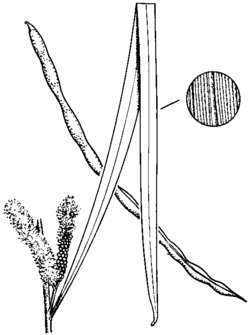Common name: currawang, lancewood, spearwood
Acacia doratoxylon A.Cunn. APNI* Synonyms: Racosperma doratoxylon (A.Cunn.) Pedley APNI*

Description: Erect or spreading tree or shrub 3–8 m high; bark hard, shallowly fissured and somewhat flaky, brown; branchlets angled towards apices, glabrous or appressed-hairy.
Phyllodes very narrowly elliptic to ± linear, straight to slightly curved, 9–20 cm long, usually 2–7 mm wide (occasionally some phyllodes to 8 mm or more wide), green or bright green, glabrous, numerous longitudinal veins faint with usually only midvein prominent, apex acute with a mucro; glands absent or 1 small gland at base; pulvinus 1.5–4 mm long.
Inflorescences usually 2–5 on an axillary axis 2–15 mm long; peduncles mostly 1–4 mm long (rarely to 6 mm long), ± appressed-hairy or scurfy; heads cylindrical, usually 2–3.5 cm long, bright yellow; calyx densely hairy.
Pods ± straight, ± flat but slightly raised over seeds, barely or slightly constricted between seeds, 4–10 cm long, 2–4 mm wide, papery and brittle, sparsely hairy or glabrous; seeds longitudinal; funicle expanded towards seed.
Flowering: usually August–November.
Distribution and occurrence: west from Wollemi to Ivanhoe district and south from Brewarrina. Grows in eucalypt and Callitris woodland on rocky ridges, and mallee in red sand.
NSW subdivisions: CT, ST, NWS, CWS, SWS, NWP, SWP, NFWP
Other Australian states: Vic.
The name means spearwood, alluding to its use by the aborigines. Similar and closely related to Acacia caroleae in general appearance but differs in flower morphology (calyx sparsely hairy at base and apex in A. caroleae) and phyllodes commonly being broader, more curved (particularly towards the apex) and a brighter green (phyllodes 1.5-5 mm wide, often straighter and more bluish or grey-green in A. caroleae). A. doratoxylon reshoots from the roots following fire. A variable species. Specimens from the upper Kowmung River (CT) have finer phyllodes that are not as stiff, and have yellowish (rather than whitish) hairs on the calyx.
Text by P.G. Kodela (December 2005)
Taxon concept: P.G. Kodela & G.J. Harden, Flora of NSW Vol. 2 (2002)
APNI* Provides a link to the Australian Plant Name Index (hosted by the Australian National Botanic Gardens) for comprehensive bibliographic data
***The AVH map option provides a detailed interactive Australia wide distribution map drawn from collections held by all major Australian herbaria participating in the Australian Virtual Herbarium project.
|


